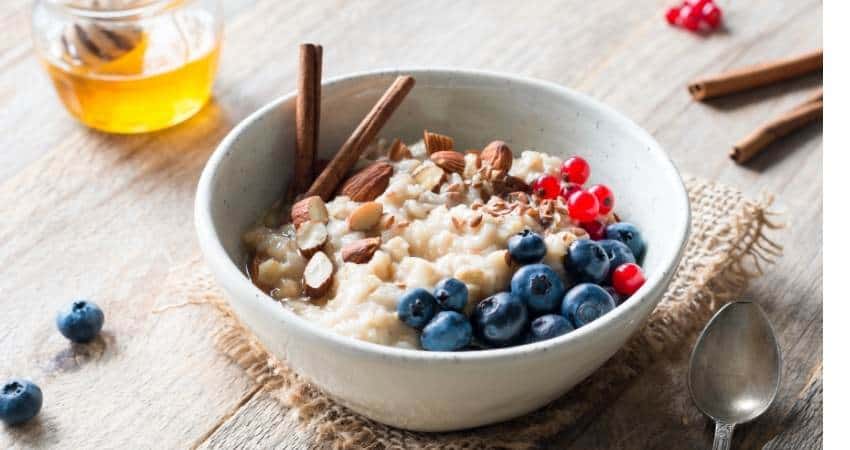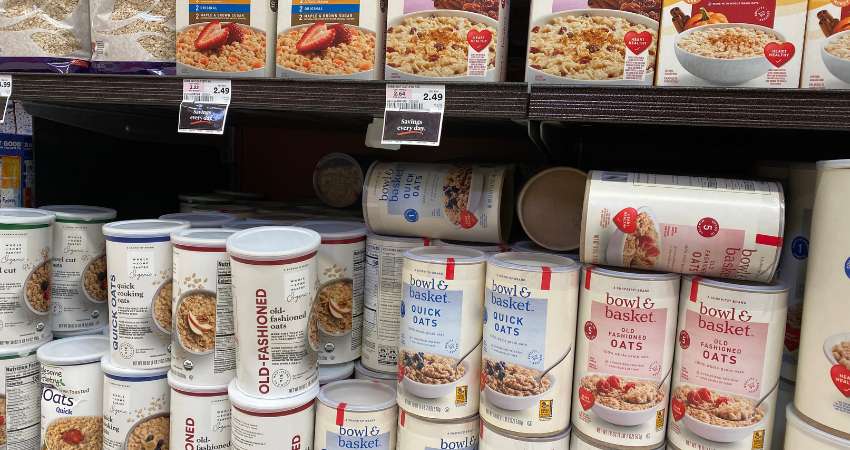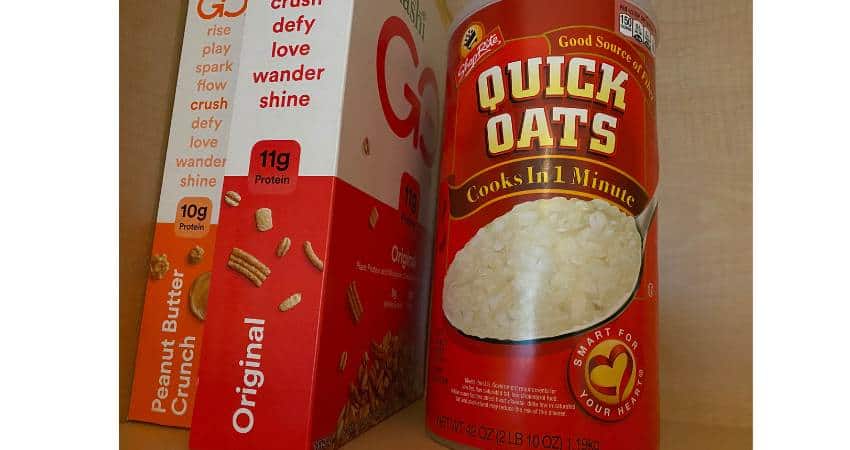Instant Oatmeal vs Oatmeal: The Oats Difference
There are many different kinds of oatmeal including instant. This may be confusing about which one to pick which is why many of my health coaching clients ask about it. Let’s answer, what’s the difference between instant oatmeal and oatmeal?
Regular oatmeal oats are made by steaming oat groats so they’re soft and then rolling the groats into flakes. Instant oats are steamed longer, rolled thinner and dehydrated so they can cook faster. Instant oats cook in minutes while regular oatmeal cooks for 5 minutes. Instant is creamier than regular.
This article will explain all the differences between the two including their nutrients and glycemic index scores. In addition, I’ll examine their tastes, textures, costs and health benefits.
In addition to coaching clients about them, I’ve purchased, researched and consumed both prior to, during and sometimes after writing this article. I routinely consume both types.
Are Instant Oatmeal and Old-Fashioned Oatmeal the Same?
Instant oatmeal is sold in packets while old-fashioned, regular oats are sold in containers. Instant oats can be added to boiling water or milk and is ready in one minute. Old-fashioned oats are cooked in water or milk over medium heat for 5 minutes. Instant oats are finely cut and rolled thinner than old-fashioned oats.

There are 4 types of oats:
Old-fashioned or Rolled
Regular, old-fashioned rolled oats are made by steaming oat groats so they’re soft and then rolling them into flakes. Doing this stabilizes the oils and extends their shelf life.
This steaming process also partially cooks the flakes so cooking doesn’t take as long as steel cut.
Instant Oats
Instant oatmeal is partially cooked and dried for fast preparation so the cooking time is shorter. They can be plain and unsweetened, but often, they’re sold in flavored packets containing many sweeteners, salt and artificial ingredients.
Instant oats come in the original, unflavored but also have numerous flavors. The flavored type has added ingredients, sweeteners and sugar. The original version is healthier.
It makes a hearty and fast-cooking option for you.
Steel-Cut Oats
Steel-cut oats are cut into a few pieces with sharp metal blades and have a nuttier flavor than rolled oats. This kind takes longer to cook than rolled oat, and they have a chewier texture.
Quick Cook Oats
Many people confuse these with instant. Quick oats are sold in larger containers like the old-fashioned and not in packets. Quick oats cook fast and can be finished cooking in one minute
Overnight Oats
They are any type of oats soaked in milk or water and left in a bowl overnight. By the morning time you could just eat them cold since they softened up overnight.
Overnight oats retain more nutrients than cooked oats.
Pros and Cons
Instant
Many people like instant because it’s easy to make, fast and tastes good. But not everyone is a fan of instant oatmeal due to the unhealthy ingredients it may contain.
Pros
- Extremely short cooking time.
- Good for baking because the oats are so fine.
- Most instant is flavored.
Cons
- Processed from their original form.
- Higher on the glycemic index.
- Flavored instant are higher in sugar.
- They often have preservatives and additives.
Oatmeal
Old-fashioned oats is great because it tastes good and nutritious. However, it’s not as easy as instant to prepare. For this reason, some people prefer instant to old-fashioned.
Pros
- Less processed than instant.
- Heartier taste and texture.
Cons
- Require a longer cooking time.
- Not flavored.
Check out the pros and cons of overnight vs regular oats in my article.
Nutritional Comparison
The following table is a side-by-side comparison of the nutrients contained in a 40-gram serving of three common types.
| Oatmeal (40 g) | Instant Oats (40 g)
(Fortified) Classic |
Instant Oats (40 g)
Apples & Cinnamon |
|
| Calories | 150 | 142 | 148 |
| Protein | 5 g | 5 g | 4 g |
| Carbohydrates | 27 g | 25 g | 31 g |
| Fiber | 4 g | 4 g | 4 g |
| Fat | 3 g | 3 g | 2 g |
| Sodium | 0 mg | 107 g | 148 g |
| Sugar | 0.99 mg | 1 g | 11 g |
| Magnesium | 40 mg | 40 mg | 40 mg |
| Phosphorous | 130 mg | 185 mg | 185 mg |
| Potassium | 150 mg | 142 mg | 139 mg |
| Iron | 1.5 mg | 11.1 mg | 1.1 mg |
| Calcium | 20 mg | 171 mg | 18 mg |
They contain the same types of nutrients. This causes many people to wonder if one is healthier.
Regular oats is healthier than instant due to its lower percentage of sugar and sodium. Regular has a lower glycemic index than instant oats which mean less sugar spikes and better digestion. Many instant oats have unhealthy additives while regular doesn’t.
If you’re going to choose instant oats, pick the original without added flavor. The flavored variety, like the apples and cinnamon listed above contains more sugar, sodium, carbohydrates and flavor additives.
I routinely consume the quick or regular oats and add in bananas, blueberries and mixed nuts.

Taste and Texture of Oats
It’s not always about the nutrients provided. Many times people choose one food over the other for recipes because of its taste or according to their mood.
Since there are some similarities between the two, like both being oats, many people wonder if they both taste the same in recipes.
Instant oatmeal and regular oats have a similar taste. They are both bland and unsweet. Instant is thinner which makes them creamier in recipes than the thicker more chewier regular.
Instant oat has a bland and earthy taste. Adding ingredients or seasonings will add more flavor similar to the addition. It’s creamier and smoother due to its thinner flakes.
Old-fashioned rolled oats have a chewier texture.
To conduct some original research, I polled some of my readers and people in food groups I belong to. I asked, do you prefer the taste of instant or regular old-fashioned for breakfast recipes?
- 52% said they preferred the taste of regular oats.
- 40% said they preferred the taste of instant oats.
- 8% said they had no preference.
I thought it would be fun to setup a taste test at my home with four people, including myself. Three out of four chose the regular.
In the battle of taste, regular was the winner in the poll and in my own taste test at home.
Find out if granola had more nutrients in my article.

Find out how quinoa compared in my article.
Glycemic Index of Instant Oats and Oats
Knowing the glycemic index of food is important especially if blood sugar levels are a concern. Avoiding blood sugar spikes is an important part of consuming healthy food.
Foods on the GI scale are categorized as:
- Low-GI foods: 55 or under
- Medium-GI foods: 56-69
- High-GI foods: 70 or over
How blood sugars levels are affected:
- Foods with a glycemic index 70 or more cause a quicker spike in blood sugar levels.
- Foods with a glycemic index 56 to 69 cause a moderate spike in blood sugar levels.
- Foods with a glycemic index 55 or less cause a slow spike in blood sugar levels.
Having more knowledge of the glycemic index of food and how it raises blood sugar when cooking oats, many people wonder if one has a higher score than the other.
Instant oatmeal has a higher glycemic index than regular oats due to the extra processing of the instant oats. Instant has a glycemic index of 83 while oats rolled have a glycemic index of 55.
Find out how oats compared to brown rice in my article.
Cost of Oats
It seems every time I check out at the supermarket the price is higher than the last time. Not only that but it also seems I have less groceries in my shopping cart.
The cost of food certainly matters to most people. The price may sway your decision about which one to use in your recipes more often.
Instant oatmeal costs more per serving than regular oats. The average price for instant oatmeal is $0.26 per 1/2 28 gram serving. The average price for regular oats is $0.20 per 40 gram serving.
I decided to conduct some original research of various different stores to compare the price of both.
I first visited the Shoprite supermarket:
- Quaker old-fashioned regular
- $4.19 per 18 oz container (13 servings) equaling $0.32 per 40 g serving
- Quaker instant oatmeal – Original
- $4.49 per 12 0.99 oz packets (12 servings) equaling $0.37 per 28 g serving
It’s important to note the regular servings are larger than the instant making them even more affordable.
I then checked Walmart:
- Regular oat (Store brand)
- $2.58 per 42 oz container (30 servings) equaling $0.09 per 40 g serving
- Instant oat (Store brand)
- $3.12 per 20 1.05 oz packets (20 servings) equaling $0.15 per 30 g serving

Find out how oat compared to Cream of Wheat in my article.
How To Store
Whichever you choose or have on hand, proper storage is crucial. How you store either one can affect how long they last before going bad and how they taste. Therefore, let’s take a closer look at the storage method recommended.
Store unopened instant oatmeal and oats in a cool, dry place away from the heat and sun. Opened regular should be tightly covered in its original container, glass or plastic container or resealable bag. Opened, instant packets should be transferred to a sealed container.
After either one is cooked, they should be refrigerated in a sealed container up to 3-4 days.
Opened and resealed can be stored up to one year. Always check the dates on the packaging. Typically, the “best if used by date” is a quality suggestion3.
I store my opened in its original container inside a cool cabinet in my kitchen away from the heat.

Health Benefits
If you’re seeking a healthy breakfast option, you really can’t go wrong with any kind of variety, except for the flavored types. Always stick with the original, unflavored for the most benefits.
Oats are whole grains and are great sources of fiber and plant-based protein. The nutrition content varies slightly between instant oatmeal, steel-cut and quick-cooking oats, except the sugar and sodium content of flavored.
The following are the benefits received from the nutrients contained in the different varieties.
Find out if there is a difference in benefits between steel-cut oats and oats in my article.
Fiber
Both types are high in soluble fiber, which is helpful for many reasons ((National Center for Biotechnology Information: Mechanisms linking dietary fiber, gut microbiota and colon cancer prevention)). What makes fiber soluble is it dissolves in water.
Soluble fiber is known for the following:
- Help overall digestive health.
- Decrease the risk of diabetes by managing the blood glucose levels.
- Helps avoid constipation and have a more regular stool.
- Aids greatly in weight management because it allows you to feel full faster and eat less.
B Vitamins
The B vitamins provided by both oat or oat flour include the following:
- B1 (thiamin)
- B2 (riboflavin)
- B3 (niacin)
- B5
- B6
- B9 (folate)
B vitamins help support the following:
- Digestion.
- Nerve function.
- Cardiovascular disease.
- Red blood cells.
- Brain function.
- Energy levels.
A lack of B vitamins has been associated with oxidative stress and neural inflammation. In a study released in 2018 32 healthy adults were given B vitamin supplementation for six months. The results indicated preliminary evidence B vitamin supplementation reduced oxidative stress and inflammation4.
Is oatmeal better than eggs? Find out in my article here.

Calcium
Calcium is important for the heart and blood pressure. Harvard Health reports calcium helps maintain blood pressure by helping in the controlling of the relaxing and tightening of blood vessels5.
Calcium also helps the following:
- Helps nerve function.
- Help the muscles to function properly.
- Build and maintain strong bones.
Potassium
Some medical experts recommend the potassium to sodium ratio of 4:1. Consuming too much sodium or not enough potassium throws off the delicate balance the kidneys need to remove the excess water6.
Potassium helps the body get rid of excess sodium reducing fluid build-up. These help keep systolic and diastolic blood pressure lower ((American Heart Association: How Potassium Can Help Control High Blood Pressure)).
According to Harvard Health, a number of studies have shown a connection between low potassium levels and high blood pressure7. The more potassium, the more sodium your body will lose.
Magnesium
The magnesium provided by both varieties helps keep blood pressure levels stable and balanced. Recent scientific research examined previous studies and concluded magnesium supplementation decreased systolic and diastolic blood pressure8.
Magnesium helps control the following:
- Muscle
- Blood pressure
- Insomnia
- Blood sugar
- Nerve function
In the heart and muscles, magnesium competes with calcium to help the muscles relax after contracting. When the body is low in magnesium, calcium can over stimulate the heart muscle’s cells causing a rapid or irregular heartbeat9.
Phosphorus
Phosphorus has been shown in scientific studies to help with the following:
- Muscle recovery and contraction.
- Help the body store and manage energy.
- Promote healthy nerve conduction.
- Promote bone and teeth strength.
- Help the kidneys remove waste.
Gluten-Free
Oatmeal and instant oatmeal made from just oats are naturally gluten-free and might be a great substitute to other gluten-heavy items of a similar taste. Even those who don’t have a completely gluten-free diet may benefit from cutting down on their gluten.
Even though they are gluten free, there is some cross contamination risk. See the following note.
Important: Although oats and granola made from just oats and honey are gluten free, they may come in contact with gluten-containing grains in storage or during transportation. Most of the Quaker products have solved this issue and label those products gluten free. Always check the label of your products to determine if its gluten free.
Iron
Much higher in iron than other grains, either type is an excellent choice if you need getting your daily value of iron. Iron is essential in the creation of red blood cells and is a necessary part of any healthy diet.
Iron is also vital for growth and development, as some hormones need iron to be appropriately balanced10.
If you have any questions about this article don’t hesitate to email us. You can find an email on our contact page.
Read Next – More Oatmeal vs Food Articles!
Muesli vs Oatmeal – What’s The Difference? Let’s Compare
Oatmeal vs Rice: Which Is More Healthy? (We Find Out)
- USDA: Cereals, oats, regular and quick, unenriched, cooked with water (includes boiling and microwaving), without salt [↩]
- USDA: Rolled Overnight Oats [↩]
- Michigan State University: Dry oatmeal needs careful handling [↩]
- National Center for Biotechnology Information: The Effect of a High-Dose Vitamin B Multivitamin Supplement on the Relationship between Brain Metabolism and Blood Biomarkers of Oxidative Stress: A Randomized Control Trial [↩]
- Harvard Health: Key minerals to help control blood pressure [↩]
- National Center for Biotechnology Information: The Effect of the Sodium to Potassium Ratio on Hypertension Prevalence: A Propensity Score Matching Approach [↩]
- Harvard Health: Potassium lowers blood pressure [↩]
- National Center for Biotechnology Information: Effect of magnesium supplementation on blood pressure: a meta-analysis [↩]
- National Institutes of Health: Magnesium [↩]
- National Institutes of Health: Iron [↩]
